May 23 (newsonjapan.com) - Historians believe that ‘kyūjutsu’ - the ‘art of archery’ in Japanese - goes back as far as the stone age, with the earliest documented use of the bow occurring at the beginning of recorded history (around 500 B.C.).
Over the years, kyūdōka (practitioners of Japanese archery) have become the stuff of legend, often depicted as deadly long-range fighters who were often the first line of offense during the time of Samurai. In truth, many were peasants who had been trained by their feudal lords to serve as infantry units. At least part of Japan’s archery culture came from China, as the inherent cultural exchange between civilizations who exist in close proximity.
The use of the bow continued throughout the millennia - including the rise of mounted archery throughout the 1100s - until around the 16th century when the arrival of firearms from Europe rendered archery obsolete as a form of practical warfare. The practice fell out of use until its revival during the Edo period (the 17th century onward), when it became a ceremonial practice used by peasants and monks rather than members of the samurai caste exclusively. With the advent of the Meiji era, bowmanship once again fell out of practice, as samurai - and the concept of a “warrior class” - became a thing of the past. It wasn’t until around the year 1900 century that kyūdō was re-established as a form of competition, leading to the founding of archery schools and ultimately, the formation of the All Japanese Kyudo Federation (ANKF).
Today, archery is still a big part of Japanese culture, from the recreational novices who practice at the range to the highly-skilled experts who participate in intense competitions like the world championships, archery events and the olympics. Most historians agree that the design of the Japanese longbow hasn’t changed in several centuries, partly due to its simple effectiveness, but also because Japanese reverence for historic practices in martial arts. Traditional Japanese archers used a yumi, the Japanese word for longbow, which was made of bamboo with a leather grip, noteworthy because of its height, which exceeded that of an average person. Today, real bamboo is sometimes replaced by a synthetic composite made of fiberglass, which mimics the appearance, texture, and sturdiness of traditional bamboo. The synthetic versions are less durable, but are also less expensive than natural bamboo, so an amateur might begin his or her training using ‘lesser’ materials to avoid damaging more valuable alternatives. Bamboo’s tendency to warp in extreme conditions makes it susceptible to weathering and storage conditions, so caring for the bow is a serious practice that requires considerable expertise and care. Also, other archery equipment is increasingly being made from modern materials.
Japanese arrows, called ‘ka’, are also usually composed of bamboo, with feathers from various birds of prey, such as eagles, hawks, and falcons. Modern alternatives are often made of aluminum.
Competitive Japanese Archery Today
The following facts are to give you an idea of Japanese skill among modern archers, according to statistical standings. The scope would be too large to include all figures, so we’ve curated a few highlights, according to the World Archery Federation:
In competitions with the recurve bow, the highest-ranking Japanese archer in the world is Osaka resident Takaharu Furukawa, a 36-year-old archer who ranks 33rd.
The highest-ranking paralympian (competitions among disabled archers who shoot from a wheelchair) is Ueyama Tomohiro, who ranks 5th in the world in the category of recurve men open (‘open’ meaning available to all, disabled or not).
Among women who compete with the recurve bow, 26-year-old Sugimoto Tomomi is the most prominent. She ranks 10th in the world, with a 63% win percentage in 52 matches, including gold medals in the World Championships in 2016 and 2019, and another in the Jakarta Asian Games in 2018.
Shigesada Chika is the highest-ranking female paralympian, ranking 8th among practitioners of the recurve bow. She had won 8 matches in a row before losing to Hazel Chaisty (9th) in the 2020 Para Archery World Ranking Tournament.
Rankings are current at the time of publication of this article and may change over time.
The 2020 Tokyo Olympics
The Summer Olympics are returning to Tokyo in 2021 for the first time since 1964. The event is still called the 2020 Olympics in accordance with the tradition of holding it every four years, even though the games were postponed due to COVID-19. Unlike many of the other competitions where the playing field is relatively even, it can be assumed that the Japanese archers will have the home-field advantage in their competition. The archery events will take place in Yumenoshima Park, a former landfill that was rehabilitated in 1967. These are the finalists from Japan who will compete in their respective competitions:
Recurve - Men
- Takaharu Furukawa
- Hiroki Muto
- Yuki Kawata
- Hideki Kikuchi (reserve)
Recurve - Women
- Ren Hayakawa,
- Azusa Yamauchi
- Miki Nakamura
- Ohashi Tomoka (reserve)









